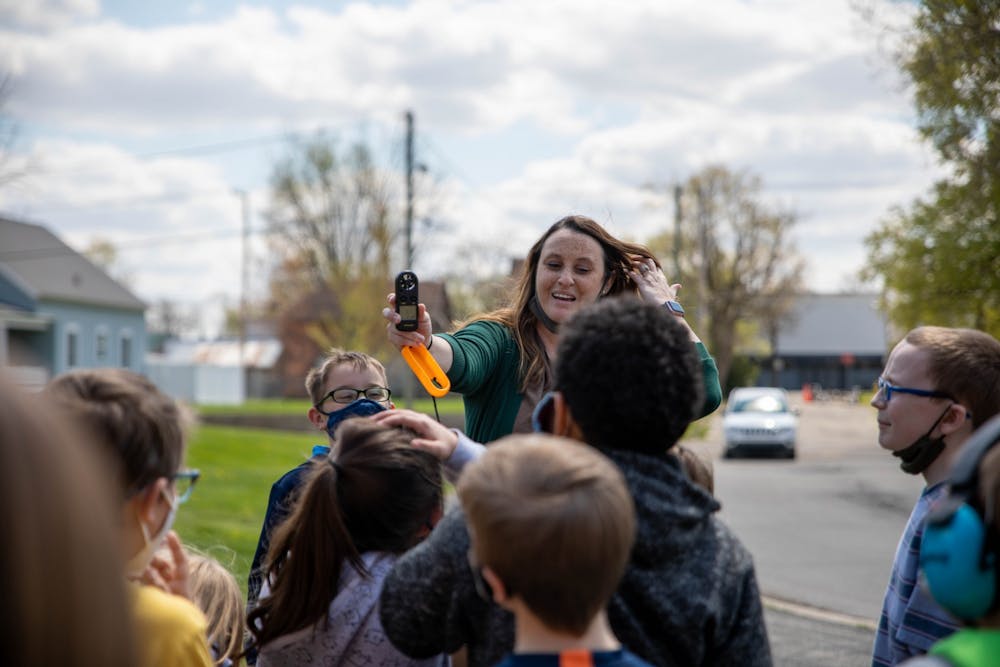What grades 1-5 learn in Project Lead The Way courses
First grade - Light and Sound: Students learn about the basics of light and sound. They record data from investigating the sun, moon and stars and also learn about animal adaptations.
Second grade - Properties of Matter: Students learn about biodiversity, classify different kinds of materials by their properties and research how animals disperse seeds and pollinate.
Third grade - Programming Patterns: Students explore the foundations of programming, record data related to precipitation, temperature and wind, and are introduced to life cycles.
Fourth grade - Collisions: Students learn how energy transfers, explore how computers work and relate them to the human body and its relationship to the environment.
Fifth grade - Infection: Detection: Students inspect the transmission of infections and how the body stays healthy, learn about the three states of matter and how energy flows in different ecosystems.
Source: Chuck Reynolds, associate superintendent of Muncie Community Schools
Editor's Note: This story is part of The Partnership Project, a series of content written in an effort by The Daily News to follow the formal collaboration of Ball State University and Muncie Community Schools. Read more in this series here.
Crime scene examination usually isn’t part of eighth-grade curricula, but Muncie Community Schools (MCS) students have the opportunity to explore it and other topics as the district expands Project Lead The Way (PLTW) into all grades one through eight.
PLTW was founded in 1997 in Indianapolis and aims to bring more STEM curriculum into the classroom. Muncie Central High School began integrating PLTW into its curriculum in 2015, giving students the option to pursue the biomedical program.
“It’s focused on learning,” MCS Associate Superintendent Chuck Reynolds said, “not just completing tasks.”
Reynolds said three teachers from both Northside and Southside middle schools are certified in teaching PLTW in grades six through eight. Sixth-grade students learn to create apps, seventh-graders complete an “innovators and makers” program and eighth-graders explore and investigate different crime scenes.
These technology courses are built into the daily schedule at Northside and Southside middle schools, so students attend a PLTW class each day until the semester ends.
“It builds its content with students seeking problems, not just problem solving,” Reynolds said. “Seeking answers or seeking problems that need answers and need solutions — it works through STEM activities.”
PLTW provides textbooks and other materials needed to teach the lessons. Reynolds said Ball State University, the George and Frances Ball Foundation and the Ball Brothers Foundation covered $350,000 of these expenses.
Reynolds said a four-day training was offered twice last year for teachers to earn PLTW certification.
“We are hoping that teachers will enjoy those hands-on learning experiences and adapt that to their other instructional practices,” Reynolds said. “We’re hoping to see problem-seeking type[s] of activities transfer across all classrooms.”
Erica Collins, sixth- and seventh-grade teacher at Northside Middle School, began teaching PLTW at the beginning of the 2020-21 school year. She teaches the basics of programming to seventh-grade students.
Collins said her students create simple, working programs on a small computer called a micro:bit. The micro:bit is designed for block code, which Collins said is easy to learn, but she said she also has students who choose to use JavaScript.
“They have to create physical computing systems that work,” Collins said. “For example, an alarm system that will trip if you open a door or if you get into a book of secrets.”
Students spend a semester learning how to code, Collins said, then make a program as their final project. In the past, students have programmed automatic pet food dispensers or a safety device, such as flashing lights for bike helmets.
“Kids really love an opportunity to do hands-on learning, which is really what this is,” Collins said. “They’re actually building things.”
Some students choose to teach themselves complicated coding languages to complete this project, Collins said.
Giving the students the ability to be problem solvers is the most important aspect of PLTW for Collins.
“It’s hard to teach kids to persevere and to be confident in their own problem-solving abilities,” Collins said. “I think a class like this really allows them [to grow in their confidence].”
When introducing the PLTW curriculum at the beginning of each semester, Collins asks students to think of a problem they would like to solve.
“The way we interact with technology in our daily lives is expanding at such a pace,” Collins said. “We don’t even know what these kids will need to be able to do, but we do know that problem solving is going to be a huge part.”
Contact Mackenzie Rupp with comments at msrupp@bsu.edu or on Twitter at @kenzieer18.





